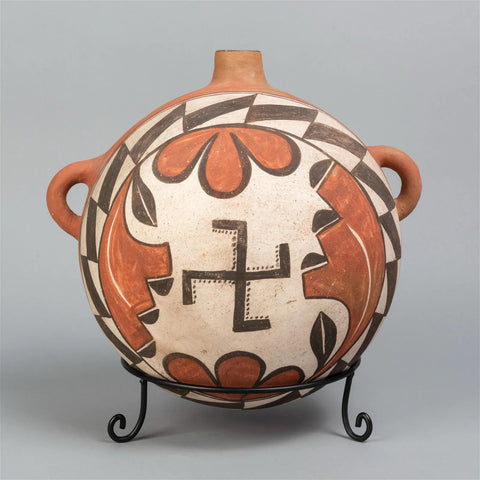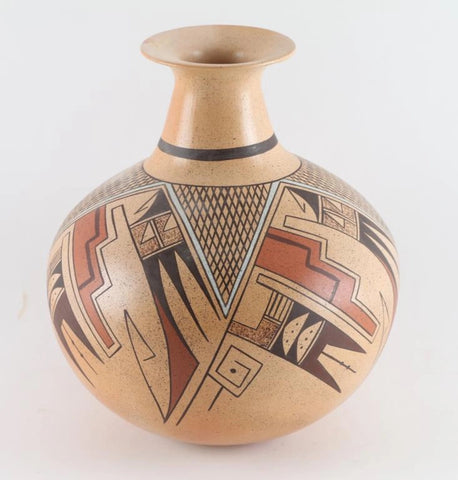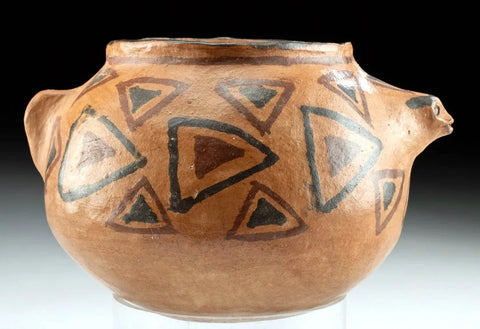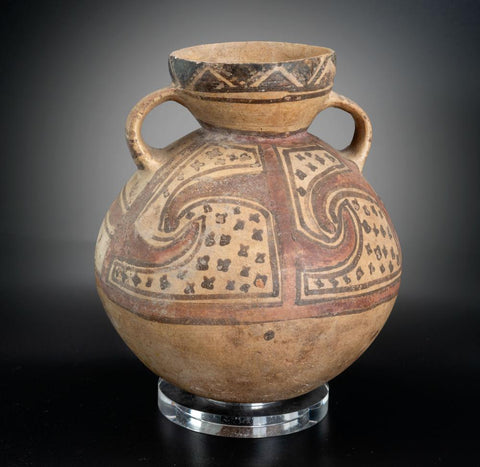Vintage Hopi Poly Chrome Pottery Bowl, Priscilla Namingha Nampeyo, Ca 1970, #1318 a
$ 1,800.00
Native American Vintage Hopi Poly Chrome Pottery Bowl, by Priscilla Namingha Nampeyo, Ca 1970, #1318a
Description: #1318 a Native American Vintage Hopi Poly Chrome Pottery Bowl, by Priscilla Namingha Nampeyo, Ca 1970,
Dimensions: 8.5 " x 4.25"
Condition: Excellent for its age
Priscilla Namingha Nampeyo (b.1924) is a third generation descendant of Nampeyo of Hano. Her mother was Rachel Namingha Nampeyo and her grandmother was Annie Healing Nampeyo. She has continued using the Sikyatki revival designs taught to her by her relatives. She is an outstanding potter and her designs are beautifully executed.
Priscilla's pots evoke her great-grandmother Nampeyo's work, but her own spiritual connection to clay is as much a part of the heritage she carries as are the designs and the technique. "I always pray when I do my pots, and I tell my children to do the same thing," she said in the early 1990s.
Priscilla is spry as ever and determined to keep on potting. In this, she carries on an age old tradition, passed down from generation to generation, and revitalized by her great- grandmother - the original Nampeyo.
Her work is featured in galleries and museums across the country. They are increasingly rare, and unless you are on a long waiting list, the likelihood of finding one is slim. Don't miss this chance to add a traditional piece of Hopi pottery by a living matriarch to your collection! Source: Ancient Nations
A History of Pueblo Pottery:
“Pueblo pottery is made using a coiled technique that came into northern Arizona and New Mexico from the south, some 1500 years ago. In the four-corners region of the US, nineteen pueblos and villages have historically produced pottery. Although each of these pueblos use similar traditional methods of coiling, shaping, finishing and firing, the pottery from each is distinctive.
Various clay's gathered from each pueblo’s local sources produce pottery colors that range from buff to earthy yellows, oranges, and reds, as well as black. Fired pots are sometimes left plain and other times decorated—most frequently with paint and occasionally with appliqué. Painted designs vary from pueblo to pueblo, yet share an ancient iconography based on abstract representations of clouds, rain, feathers, birds, plants, animals and other natural world features.
Tempering materials and paints, also from natural sources, contribute further to the distinctiveness of each pueblo’s pottery. Some paints are derived from plants, others from minerals. Before firing, potters in some pueblos apply a light colored slip to their pottery, which creates a bright background for painted designs or simply a lighter color plain ware vessel. Designs are painted on before firing, traditionally with a brush fashioned from yucca fiber.
Different combinations of paint color, clay color, and slips are characteristic of different pueblos. Among them are black on cream, black on buff, black on red, dark brown and dark red on white (as found in Zuni pottery), matte red on red, and polychrome—a number of natural colors on one vessel (most typically associated with Hopi). Pueblo potters also produce undecorated polished black ware, black on black ware, and carved red and carved black wares.
Making pueblo pottery is a time-consuming effort that includes gathering and preparing the clay, building and shaping the coiled pot, gathering plants to make the colored dyes, constructing yucca brushes, and, often, making a clay slip. While some Pueblo artists fire in kilns, most still fire in the traditional way in an outside fire pit, covering their vessels with large potsherds and dried sheep dung. Pottery is left to bake for many hours, producing a high-fired result.
Today, Pueblo potters continue to honor this centuries-old tradition of hand-coiled pottery production, yet value the need for contemporary artistic expression as well. They continue to improve their style, methods and designs, often combining traditional and contemporary techniques to create striking new works of art.” (Source: Museum of Northern Arizona)
----------
View the other items in my shop: http://www.etsy.com/shop/CulturalPatina?ref=shopsection_shophome_leftnav
Description: #1318 a Native American Vintage Hopi Poly Chrome Pottery Bowl, by Priscilla Namingha Nampeyo, Ca 1970,
Dimensions: 8.5 " x 4.25"
Condition: Excellent for its age
Priscilla Namingha Nampeyo (b.1924) is a third generation descendant of Nampeyo of Hano. Her mother was Rachel Namingha Nampeyo and her grandmother was Annie Healing Nampeyo. She has continued using the Sikyatki revival designs taught to her by her relatives. She is an outstanding potter and her designs are beautifully executed.
Priscilla's pots evoke her great-grandmother Nampeyo's work, but her own spiritual connection to clay is as much a part of the heritage she carries as are the designs and the technique. "I always pray when I do my pots, and I tell my children to do the same thing," she said in the early 1990s.
Priscilla is spry as ever and determined to keep on potting. In this, she carries on an age old tradition, passed down from generation to generation, and revitalized by her great- grandmother - the original Nampeyo.
Her work is featured in galleries and museums across the country. They are increasingly rare, and unless you are on a long waiting list, the likelihood of finding one is slim. Don't miss this chance to add a traditional piece of Hopi pottery by a living matriarch to your collection! Source: Ancient Nations
A History of Pueblo Pottery:
“Pueblo pottery is made using a coiled technique that came into northern Arizona and New Mexico from the south, some 1500 years ago. In the four-corners region of the US, nineteen pueblos and villages have historically produced pottery. Although each of these pueblos use similar traditional methods of coiling, shaping, finishing and firing, the pottery from each is distinctive.
Various clay's gathered from each pueblo’s local sources produce pottery colors that range from buff to earthy yellows, oranges, and reds, as well as black. Fired pots are sometimes left plain and other times decorated—most frequently with paint and occasionally with appliqué. Painted designs vary from pueblo to pueblo, yet share an ancient iconography based on abstract representations of clouds, rain, feathers, birds, plants, animals and other natural world features.
Tempering materials and paints, also from natural sources, contribute further to the distinctiveness of each pueblo’s pottery. Some paints are derived from plants, others from minerals. Before firing, potters in some pueblos apply a light colored slip to their pottery, which creates a bright background for painted designs or simply a lighter color plain ware vessel. Designs are painted on before firing, traditionally with a brush fashioned from yucca fiber.
Different combinations of paint color, clay color, and slips are characteristic of different pueblos. Among them are black on cream, black on buff, black on red, dark brown and dark red on white (as found in Zuni pottery), matte red on red, and polychrome—a number of natural colors on one vessel (most typically associated with Hopi). Pueblo potters also produce undecorated polished black ware, black on black ware, and carved red and carved black wares.
Making pueblo pottery is a time-consuming effort that includes gathering and preparing the clay, building and shaping the coiled pot, gathering plants to make the colored dyes, constructing yucca brushes, and, often, making a clay slip. While some Pueblo artists fire in kilns, most still fire in the traditional way in an outside fire pit, covering their vessels with large potsherds and dried sheep dung. Pottery is left to bake for many hours, producing a high-fired result.
Today, Pueblo potters continue to honor this centuries-old tradition of hand-coiled pottery production, yet value the need for contemporary artistic expression as well. They continue to improve their style, methods and designs, often combining traditional and contemporary techniques to create striking new works of art.” (Source: Museum of Northern Arizona)
----------
View the other items in my shop: http://www.etsy.com/shop/CulturalPatina?ref=shopsection_shophome_leftnav
Related Products
Sold out




